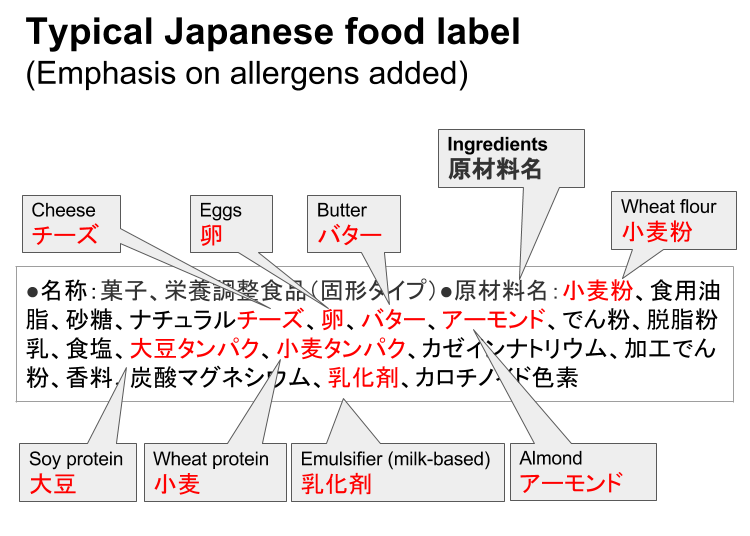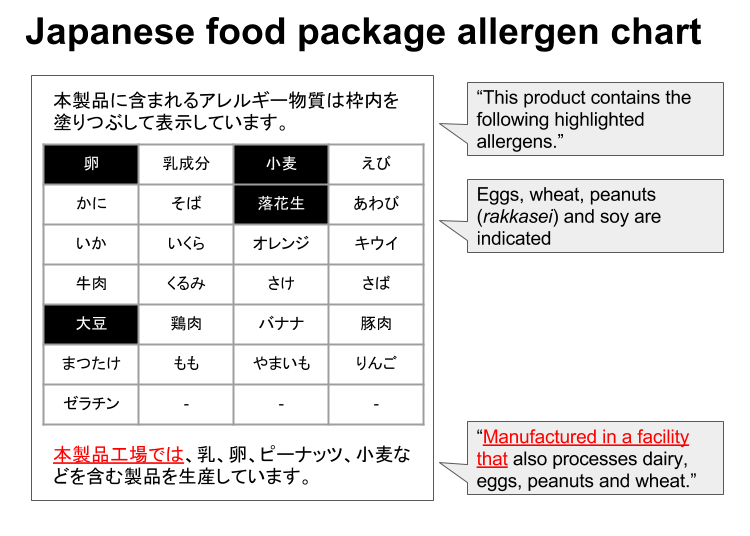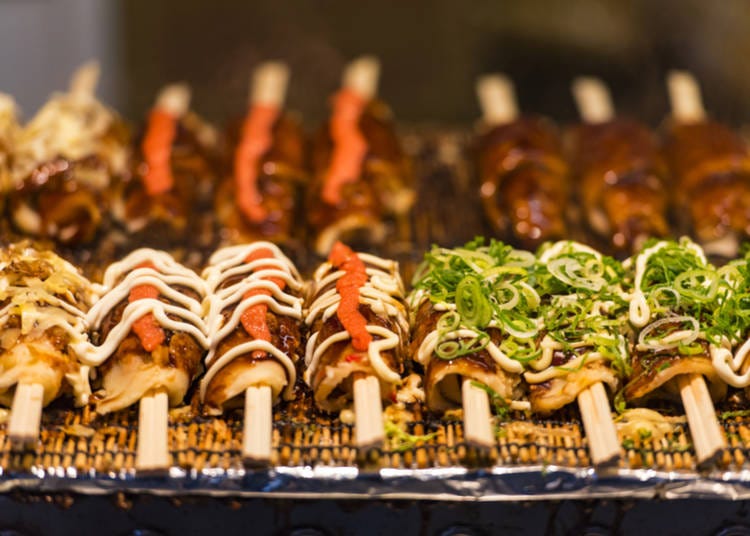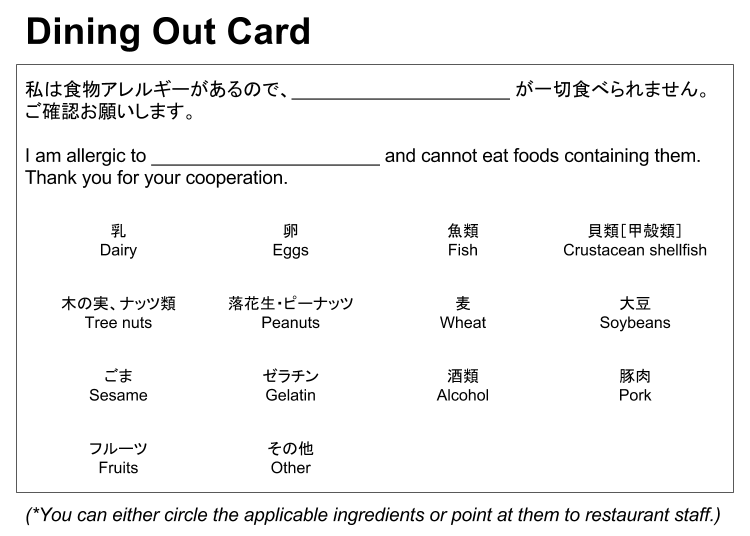
Food allergies in Japan can impose a large degree of anxiety for food allergy sufferers. This is especially in a country like Japan which does not tend to list ingredients using a Western script.
Meanwhile, many Japanese do not understand the life-threatening seriousness that food allergies can impose.
This article serves to present key information on how to explain what food allergy someone has, tips on reading food and other product labels, insight into what products can contain what kinds of allergies, and what to do in case of an allergic response.
- Table of Contents
-
- Traveling with Food Allergies in Japan
- Labelling in Japan: Japanese food labels
- How to Read Japanese Food Labels
- Common Food Allergens in Japan
- Traveling with a milk/dairy allergy in Japan?
- Traveling with an egg allergy in Japan?
- Traveling with a crustacean shellfish allergy in Japan?
- Traveling with a peanut allergy / nut allergy in Japan?
- Traveling with a sesame allergy in Japan?
- Traveling with a soy / soybean allergy in Japan?
- Lactose and Gluten Intolerance
- Special Concerns
- How to Inform of Any Food Allergies and Ask About Ingredients
- What to do in case of an Allergic Reaction in Japan
- Final thought: Japanese food labels reader app
Traveling with Food Allergies in Japan
In the US, eight ingredients account for most of the serious allergic reactions: Milk, Eggs, Fish (e.g., bass, flounder, cod), Crustacean shellfish (e.g., crab, lobster, shrimp), Tree nuts (e.g., almonds, walnuts, pecans), Peanuts, Wheat, and Soybeans.
Travelers with food allergies can still experience and enjoy Japan, though certain precautions may have to be taken. (The same goes especially for traveling with a soy allergy.)
Labelling in Japan: Japanese food labels

The food labeling system in Japan has different requirements and only 7 core allergens are required to be labelled. A list of allergenic foods in Japan is: eggs, milk, wheat, buckwheat, peanuts, shrimp and crab. Some allergens can be listed using very different forms, such as 落花生 and ピーナッツ - both of which refer to peanuts.
Note that ready-made food at outdoor stalls and vendors, small restaurants and izakayas, and many hand-made and packaged products will not be labeled. Take extra caution when choosing to consume such products as the ingredients could have come in contact with or be made in environment with allergens, even if it’s directly in the product.
While large companies often do proper labeling, many tiny businesses may not. If you do not see a label or have any questions, ask the staff. Be prepared to wait patiently as oftentimes, staff will make multiple calls and check the content meticulously to assure accuracy.
How to Read Japanese Food Labels

Under Japanese law, most food packaging of a certain size must be labeled. Ingredients are typically listed on the reverse or side of a package. Look for the phrase 原材料名 - "product ingredients" - to start reading for allergens.

Products with a larger package area may also display an allergen table (or icon) indicating which allergens the food contains.
If you are concerned about potential cross-contamination, located toward the bottom of many packages there will also be a phrase similar to the following:
本製品工場では、乳、卵、ピーナッツ、小麦などを含む製品を生産しています。
("Manufactured in a facility that also processes dairy, eggs, peanuts and wheat.”)
Common Food Allergens in Japan
Traveling with a milk/dairy allergy in Japan?
Milk & Dairy (乳, にゅう; nyuu):
●Variants: 生乳(seinyu, raw milk), 牛乳 (gyunyu, cow’s milk), 生クリーム (heavy cream).
Many products, even powdered or instant soups, crackers, and bread have dairy in them. In recent years, soy and other non-dairy type milks and yogurts have been stocked on shelves at convenient stores and supermarkets. Luckily, many traditional Japanese dishes such as udon, ramen, tempura, and the like do not have dairy in them as dairy itself was not introduced to Japan until recent centuries. Still, with the western influence in modern Japanese food, it’s best to stay cautious and pay attention to ingredients.
●Found in: creamy pastas and soups, salad toppings and dressings, desserts, crackers, creamy broth for nabé, egg omelette, egg custard, egg sandwich (which includes mayonnaise), potato salad (also mayo), many Japanese hamburger buns, white bread and pastries, and can be in skincare products that are creamy and white.
Traveling with an egg allergy in Japan?
Eggs (卵, たまご; tamago)
Egg is commonly a topping that isn’t listen on the menu, such as boiled egg on top of salads, a raw egg (safe to eat in Japan) on top of rice for a traditional Japanese breakfast, and in light soups. While these dishes are more distinct and easy to tell from the looks, there are many dishes in which egg is not as visually apparent. This includes many fried dishes (usually ending in -katsu) which use eggs and flour in the batter. Other foods in which a shape is formed (hardened) often use egg and flour in its process to do so. Make sure to check extensively.
●Found in: Sushi (tamago-yaki sushi and chirashi bowls), chikuwa, okonomiyaki (batter), chawan-mushi (savory egg custard dish), tempura (batter), tonkatsu (batter).
Fish
Examples: Salmon (サーモン, samon; さけ, sake), tuna (まぐろ, maguro)
Very commonly in soup broths, food flavorings, seasonings, and toppings. Ask extensively about ingredients as it’s often hidden and unacknowledged even by vendors.
●Found in: Ramen, onigiri, bento boxes, some salads and dressings, certain crackers, appetizers served at izakayas, fish cakes, and satuées.
Traveling with a crustacean shellfish allergy in Japan?
Crustacean shellfish (貝類, kairui; 甲殻類, kokakurui)
Examples: crab (蟹, かに; kani) / shrimp (海老, えび; ebi)
Similar to fish, crustacean shellfish is found in flavoring from snacks to seasonings and toppings.
●Found in: hot pot, fish cakes, kappa ebisen and other flavored chips and crackers
Traveling with a peanut allergy / nut allergy in Japan?
Tree nuts (木の実, kinomi)
Examples: Almonds (アーモンド, amon-doh) / pecans (ピカン, pi-kan) and Peanuts (落花生, らっかせい; rakkasei or ピーナッツ, piinattsu).
Nut allergies seem to be much more common and even a norm to some level in the west. However, it’s still on the rare side to come across a Japanese person with peanut or other nut allergies. Be extra cautious of crushed nuts as salad toppings, or to the recent boom of almond milk in Japan.
●Found in: Essential and cooking oils, raw; nut oils may be found in certain beauty products, such as shampoos, soaps and conditioners.
Traveling with a sesame allergy in Japan?
Sesame (ごま; goma)
Sesame is a very common decorative or hidden flavor. Sesame oil is used in majority of the deep fried and pan fried Japanese and Chinese dishes as well as an alternative oil to canola, olive, etc. Dumplings, fried rice sautéed vegetables are often cooked with sesame oil. Many dishes, such as salad and sashimi bowls, will be sprinkled with sesame on top for decoration and extra flavor, and often will not be listened on the ingredients on the menu so make sure to ask about it before your dish comes out with a surprise. Sesame, especially black, is often an ingredient in desserts such as red bean paste anman (steamed dumpling) and regional soft serve ice cream.
●Found in: sesame oil, salad dressings and toppings, rice bowl and noodle toppings, dipping sauces for shabu shabu or nabé, black sesame ice cream and other sweet dessert dishes.
Wheat (小麦, こむぎ; komugi)
Wheat is another common ingredient with very limited alternatives to it in Japan at this point. Soba noodles, made of buckwheat, despite its name is a delicious and safe bet, but take caution: those that are not made with 100% buckwheat may include wheat in them. Gluten free is not common and most dishes have wheat in them, from noodles to fried dishes. As wheat is also an ingredient in soy sauce, read below to find out more about the use of soy sauce in Japan.
●Found in: (mugi) tea, fried dishes which use panko, tempura, gyoza, dumplings, imitation crab, soy, ponzu, teriyaki (taré), and eel sauces
Traveling with a soy / soybean allergy in Japan?
Soybeans (大豆, だいず; daizu)
Soy, especially soy sauce, is found a majority of flavorings as Japan’s staple. Avoid soup broths such as ramen, udon, and sometimes even curry. Yakisoba sauce, tonkatsu sauce, and other dipping sauces may also have soy sauce so be sure to ask for alternatives, or plain. Vegetables, egg, and meat are sometimes boiled in flavoring with soy sauce included. Chicken skewers (yakitori) and other grilled food options come either salted or with sauce called taré which includes soy so make sure to always choose salt.
●Found in: Edamame, tofu, natto, miso, yuba, okara, kinako, red bean paste, rice crackers, inari-zushi, tamago-yaki (egg omelette), boiled eggs (with the dashi packet) and vegetables, onigiri, pickled vegetables (tsukemono), dango, soy sauce, soy milk, soy yogurt, teriyaki (taré) and eel sauce.
*Note that emulsifiers (乳化剤) may contain soy as well; typically these will be labeled as "乳化剤、大豆由来" (Emulsifier, soy derived).
Lactose and Gluten Intolerance
(e.g. Milk & Dairy, pastas, ramen, udon, breads, imitation crab, fish cakes, wheat-based snacks, seasonings such as soy sauce)
Although celiac disease and wheat allergies aren’t common among the Japanese, there is a “Gluten-Free” trend similar to the west. There are some cafés advertising gluten-free menus as well. Check extensively as many dishes are still prepared in mixed-allergen environments.
Special Concerns

Be extra cautious when going to or buying food at the locations listed below:
Night markets and street food: there are no ingredients lists, many are mom and pop owned stands or run by staff with little knowledge of every single item on the menu. Night market stands also use large, wide pan tables where all the ingredients are cooked and mixed without divisions. Avoid eating that may have hidden ingredients, or ask using an allergy card, but still take personal caution even if the vendor will tell you that it’s safe to eat.
Cross-contamination: the above scenario makes it clear that cross-contamination is highly likely, in street food as well as restaurants. Many of the older ramen shops and izakayas cook in small areas with barely any separate uses between kitchenware. Be sure to ask about possibilities of cross contamination, and to let the shop know if using the same cooking ware and pans/bowls would affect your health. Note that while nut oils are typically not used to deep-fry or fry food in Japan, it is better to ask up front.
Ryokan and hotels with food service: Having a ryokan experience where food is brought to your room is a dream for many who travel to Japan. It can be done, and most lodgings are quite good with food allergies, but be sure to check with the ryokan or booking agent before you make the reservation to see they can accommodate for dietary restrictions. Have the server also explain every dish in front of you at the time of service to ensure all safety. Many hotels also have buffets and room service that may not be so cautious about cross-contamination and allergies. Depending on your sensitivity, always be sure to contact lodging before the trip to make sure they are able to accommodate all needs, or be on the safe side by bringing some easy-to-cook meals with you on the road.
Hidden flavorings: As mentioned below many key allergens, hidden flavorings are everywhere. Japan is a land that prides itself on the attention to flavor, from dashi to umami. With any dishes that look like it has a lot of ingredients mixed in (such as fish cakes), or any dipping sauces and broths, it’s better to assume there are hidden flavorings from soy, fish, sesame, or any other. Double check with staff about the hidden ingredients. If they are not 100% certain and cannot get an answer, it’s best to avoid the dish.
Bento boxes: Bento boxes are another part of the memorable experiences while in Japan. They are sold in convenient stores, around town, and at train stations as eki-ben (station bento, designed to be eaten on train lines with tray tables such as the Shinkansen). Bentos most commonly have a little bite of everything, from salmon to boiled vegetables, pickled vegetables, rice, and meat. As bentos tend to be, they are enhanced in flavor with ingredients such as sugar, soy and may contain fish stock as well. If this would be if concern, stick to the simpler bentos such as an onigiri set or rice bowl.
How to Inform of Any Food Allergies and Ask About Ingredients

Insider Tip: Order International Allergy Cards Before Departure
The best way to assure correct communication is to create and carry around an international allergy card. This can be created on sites such as www.foodallergy.org. Cards for food and drug allergies, dietary restrictions, intolerances such as Gluten and Lactose, and medical emergencies can be easily ordered online in any languages needed. Choose to have cards printed in Japanese and English, or any other desired languages. These cards allow communication with food service and medical personnel quickly, especially in times of impeding response needs. It is also important to know what to do in case of an emergency, when asking for help from persons nearby may not be the most accessible option.
Insider Tip: Be Aware of Hidden Ingredients
Dietary restrictions (e.g. Veganism, religious reasons) are still commonly misunderstood in Japan. Animal products can be hidden in flavorings or seasonings without thorough examination and communication by food services. As a tip from longtime foreign residents of Japan, it can be of favor to simply imply restrictions as allergies. By doing so, food services are more likely to do a thorough check of all ingredients in their dishes.
- Allergy
- arerugii - アレルギー
- Can’t consume/eat _____
- _____tabe-rare-masen - _____食べられません
- Does this contain _____?
- koré wa _____ haitte imasuka? - これは__入っていますか?
- Can you make this without ______?
- ____nashi de tsukure masuka? - __なしで作れますか?
- Do you have any alternative flavorings without ____?
- ____nashi no aji-tsuke dekimasuka? - __なしの味付けできますか?
What to do in case of an Allergic Reaction in Japan
If in need of medical assistance, immediately call 119 for an ambulance. Have the address or landmark to state immediately, and be ready to provide as much information as possible such as: name, gender, age, and the reason for immediate medical assistance. While ambulances are generally free and medical costs reasonable, it is very wise and important to purchase travel insurance that includes medical needs in case of such emergencies and unforeseen hospital visits.
Insider Tip: Be Cautious of Japan’s Bystander Effect
Although in no relation to the true kind and hospitable spirit of Japanese citizens, there is a chance of the bystander effect during any emergency situation. Do not be shocked if citizens walk by even in times of medical emergencies, because it is a cultural norm and unspoken rule to avoid situations because helpers must take full responsibility of the people in need of help until the situation is resolved.
- Emergency
- kin-kyu - 緊急
- Ambulance
- kyu-kyu-sha - 救急車
- Hospital
- byo-in - 病院
- Doctor
- isha - 医者
- Allergic reaction
- arerugii-hannou - アレルギー反応
- Fainted / Fallen
- tao-reta - 倒れた
- Immediately/in a hurry
- sugu, hayaku - すぐ、早く
- Address
- jyuu-sho - 住所
- Name
- namae - 名前
- Female/Male
- jyo-sei / dan-sei - 女性 / 男性
- Adult
- otona - 大人
- Child
- kodomo - 子供
- Elderly
- rou-jin - 老人
- Age
- toshi / nen-rei - 歳 / 年齢
- ___ years old
- ___sai - __歳
Final thought: Japanese food labels reader app
As of April 2019, there is an app available in English called "Payke" which allows you to scan barcodes on packages in Japan and receive food ingredients and other details in English.
Disclaimer: Although every effort has been taken to ensure accuracy, the information provided on this page is given in good faith and is not meant to substitute for good medical advice provided by a medical professional prior to travel.
- Category
*Prices and options mentioned are subject to change.
*Unless stated otherwise, all prices include tax.
Recommended places for you
-

Man in the MoonKarasuma
Other Restaurants
Gion, Kawaramachi, Kiyomizu-dera Temple
-

Birthday Surprise x KUJIRA ENTERTAINMENT DINING
Other Restaurants
Shinjuku
-

SYOHRESUTORANNESUTOSHINJUKU
Other Restaurants
Shinjuku
-

TOKYO KAIKAN
Other Restaurants
Ginza
-

Shabuzen Umeda
Other Restaurants
Umeda, Osaka Station, Kitashinchi
-

fes Fuesu
Other Restaurants
Umeda, Osaka Station, Kitashinchi
-

Police to ticket cyclists riding on sidewalks, which amounts to almost all cyclists in Japan
-

Stay with Snorlax? Grand Hyatt Tokyo's Summer Pokémon Resort Experience Is the Ultimate Sleepover
-

'They Do What in the Toilet?!' Italians Shocked By These Japanese Beauty Quirks
by: Yuu Sato
-

A Don Quijote Like No Other: Step Inside the All-New Tourist-Friendly Store at Shinjuku Tonanguchi Bekkan (Open June 13)
by: Chehui Peh
-

Step Into the World of Chiikawa: Immersive 'Chiikawa Park' to Open in Ikebukuro's Sunshine City This July!
-

Japan Summer Sales 2025: Your Ultimate Guide to Shopping Deals In Tokyo, Kansai & More!
-

English-speaking-only bar opens in Osaka and Tokyo, yellow cards for those who don’t follow rules
-

3 Best Hotels in Kobe, Japan with Amazing Views of Kobe Bay!
-

Japan Sakura Selection: Mouthwatering Spring Delicacies Offered by 16 of Tokyo’s Top Shops!
-

Sightseeing Highlights: Experience the Appeal of Kyoto Geisha Culture
-

Dining in Kobe: 15 Must-Try Restaurants From Kobe Beef to Tapas, Desserts & Cafés
by: Tiffany YU
-

5 Best Shops for Cheap & Yummy Japanese Snacks Along Asakusa's Nakamise Shopping Street!
- #best sushi japan
- #what to do in odaiba
- #what to bring to japan
- #new years in tokyo
- #best ramen japan
- #what to buy in ameyoko
- #japanese nail trends
- #things to do japan
- #onsen tattoo friendly tokyo
- #daiso
- #best coffee japan
- #best japanese soft drinks
- #best yakiniku japan
- #japanese fashion culture
- #japanese convenience store snacks













